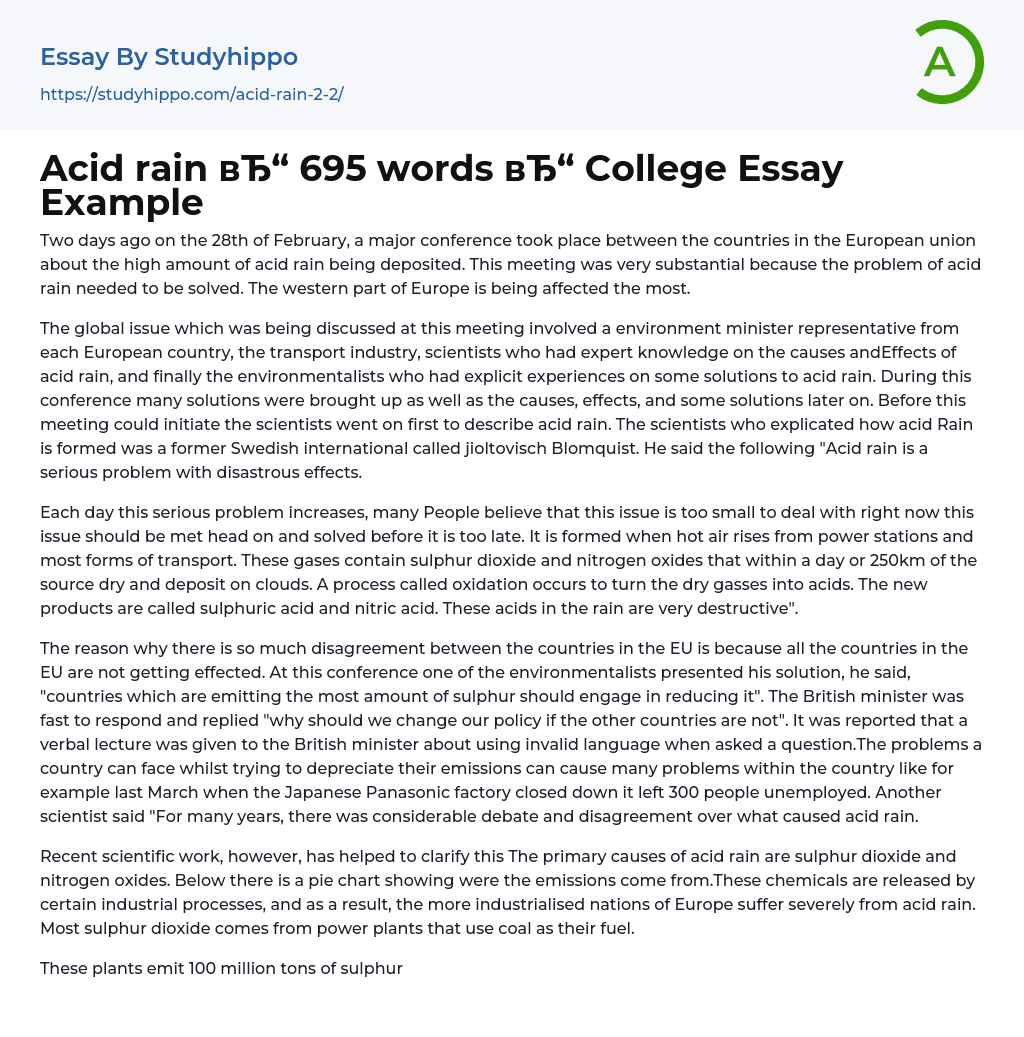The issue of acid rain is becoming increasingly concerning in western Europe and requires immediate attention. To address this critical threat, a significant conference was held by the European Union countries on February 28th.
During the meeting, attended by environment ministers from all European countries, representatives of the transport industry, and experts on acid rain causes and effects, discussions focused on addressing this global issue. The conference covered various aspects of acid rain including its causes, effects, and potential solutions. Prior to the start of the meeting, scientists provided a detailed explanation of how acid rain forms with contributions from renowned expert Jioltovisch Blomquist. He emphasized that acid rain is a grave problem with severe consequences.
The severity of air pollution cannot be ignored as it continues to increase. It is crucial to confront this issue be
...fore it becomes too severe, even though some individuals may not consider it significant currently. The core reason for this problem is the release of hot air from power plants and various forms of transportation. This hot air contains sulphur dioxide and nitrogen oxides, which settle on clouds within 250km or a day after being released. Over time, these dry gases undergo oxidation that converts them into harmful acids like nitric acid and sulphuric acid, posing serious threats when they fall as rain.
During a conference on environmental policies in the EU, member countries disagreed due to varying impacts of these policies. One environmentalist suggested that nations with high sulphur emissions should be responsible for reducing them, but a British minister argued against this proposal, stating that their policy need not change unless other countries followed suit. The minister's language drew concerns
about its appropriateness. Additionally, emission reduction measures can result in negative consequences like job loss; for example, last March's closure of a Panasonic factory left 300 people unemployed. Past discussions on acid rain have also caused division and uncertainty.
According to a recent scientific study, acid rain is mainly caused by sulphur dioxide and nitrogen oxides. The majority of these harmful emissions are produced by industrial activities in highly developed regions of Europe. The sources of these emissions are depicted in the pie chart below. Sulphur dioxide pollution is significantly contributed to by emissions from coal-fired power plants.
Fossil fuel-powered power plants and automobiles are the primary generators of nitrogen oxide emissions, constituting half of the global total. The rise in automobile usage results in increased acid rain production. Moreover, plants discharge 100 million tons of sulphur dioxide, accounting for 70% of the world's total. Although human activity is mainly accountable for acid rain, factors like fires, volcanic eruptions, bacterial decomposition, and lightning can also considerably contribute to planetary nitrogen oxide levels.
When small contaminant particles enter the atmosphere, they can spread out over long distances and combine with other substances to create harmful chemicals. Acidic precipitation, which can take the form of rain, snow, hail, fog, frost or dew, is one such chemical that negatively affects both natural habitats and human-made items like vehicle coatings when it comes into contact with the ground.
The production and negative impact of acid rain is depicted in the image above. Environmentalists assert that acid rain is damaging to both humans and natural ecosystems and action must be taken to halt its occurrence. Scientists similarly confirm the severe consequences of acid
rain in many regions and how it adversely affects those environments. Acid rain is an issue that is rapidly proliferating due to factors such as industrial processes, vehicles, and power facilities.
Developed countries experience severe acid rain problems, while undeveloped nations' industrialization will cause an increase in acid rain. Environmental ministers, scientists, and environmentalists had a conversation and agreed that acid rain must be reduced due to its detrimental effects on the environment. However, the transport industry opposes reducing acid rain because of potential profit loss. The devastating effects of acid rain are recognized by everyone else, including its ability to impede healthy tree growth in forests.
When they ought to be green and healthy, leaves and needles wither and drop. In some instances, a single tree or entire sections of the forest perish without any apparent cause.
- Organic Chemistry essays
- Acid essays
- Calcium essays
- Chemical Bond essays
- Chemical Reaction essays
- Chromatography essays
- Ethanol essays
- Hydrogen essays
- Periodic Table essays
- Titration essays
- Chemical reactions essays
- Osmosis essays
- Carbohydrate essays
- Carbon essays
- Ph essays
- Diffusion essays
- Copper essays
- Salt essays
- Concentration essays
- Sodium essays
- Distillation essays
- Amylase essays
- Magnesium essays
- Acid Rain essays
- Agriculture essays
- Albert einstein essays
- Animals essays
- Archaeology essays
- Bear essays
- Biology essays
- Birds essays
- Butterfly essays
- Cat essays
- Charles Darwin essays
- Chemistry essays
- Dinosaur essays
- Discovery essays
- Dolphin essays
- Elephant essays
- Eli Whitney essays
- Environmental Science essays
- Evolution essays
- Fish essays
- Genetics essays
- Horse essays
- Human Evolution essays
- Isaac Newton essays
- Journal essays
- Linguistics essays
- Lion essays




